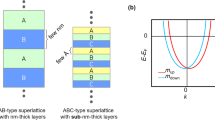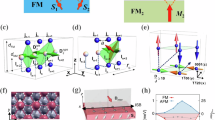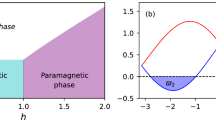Abstract
Proposals for novel spin-orbitronic logic1 and memory devices2 are often predicated on assumptions as to how materials with large spin–orbit coupling interact with ferromagnets when in contact. Such interactions give rise to a host of novel phenomena, such as spin–orbit torques3,4, chiral spin structures5,6 and chiral spin torques7,8. These chiral properties are related to the antisymmetric exchange, also referred to as the interfacial Dzyaloshinskii–Moriya interaction (DMI; refs 9, 10). For numerous phenomena, the relative strengths of the symmetric Heisenberg exchange and the DMI are of great importance. Here, we use optical spin-wave spectroscopy (Brillouin light scattering) to directly determine the volume-averaged DMI vector D for a series of Ni80Fe20/Pt thin films, and then compare the nearest-neighbour DMI coupling energy with an independently measured value of the Heisenberg exchange for each sample. We show that the dependence on Ni80Fe20 thickness of both the microscopic symmetric and antisymmetric exchange are nearly identical, consistent with the notion that the fundamentals of the DMI and Heisenberg exchange essentially share the same underlying physics, albeit with different symmetries, as was originally proposed by Moriya11 for superexchange in magnetic oxides, and by Fert and Levy12 for RKKY coupling in metallic spin glasses. Indeed, our result demonstrates the generality of the original DMI theory, insofar as the proportionality of the symmetric and antisymmetric exchange is robust with regard to the details of spin coupling for the material system in question. Although of significant fundamental importance, this result also leads us to a deeper understanding of DMI and how it could be optimized for spin-orbitronic applications.
This is a preview of subscription content, access via your institution
Access options
Subscribe to this journal
Receive 12 print issues and online access
$259.00 per year
only $21.58 per issue
Buy this article
- Purchase on SpringerLink
- Instant access to full article PDF
Prices may be subject to local taxes which are calculated during checkout




Similar content being viewed by others
References
Bhowmik, D., You, L. & Salahuddin, S. Spin Hall effect clocking of nanomagnetic logic without a magnetic field. Nature Nanotech. 9, 59–63 (2013).
Parkin, S. S. P., Hayashi, M. & Thomas, L. Magnetic domain-wall racetrack memory. Science 320, 190–194 (2008).
Miron, I. M. et al. Perpendicular switching of a single ferromagnetic layer induced by in-plane current injection. Nature 476, 189–193 (2011).
Liu, L. et al. Spin-torque switching with the giant spin Hall effect of tantalum. Science 336, 555–558 (2012).
Bode, M. et al. Chiral magnetic order at surfaces driven by inversion asymmetry. Nature 447, 190–193 (2007).
Chen, G. et al. Tailoring the chirality of magnetic domain walls by interface engineering. Nature Commun. 4, 2671 (2013).
Ryu, K.-S., Thomas, L., Yang, S.-H. & Parkin, S. Chiral spin torque at magnetic domain walls. Nature Nanotech. 8, 527–533 (2013).
Emori, S., Bauer, U., Ahn, S.-M., Martinez, E. & Beach, G. S. D. Current-driven dynamics of chiral ferromagnetic domain walls. Nature Mater. 12, 611–616 (2013).
Dzyaloshinsky, I. A thermodynamic theory of ‘weak’ ferromagnetism of antiferromagnetics. J. Phys. Chem. Solids 4, 241–255 (1958).
Moriya, T. New mechanism of anisotropic superexchange interaction. Phys. Rev. Lett. 4, 228–230 (1960).
Moriya, T. Anisotropic superexchange interaction and weak ferromagnetism. Phys. Rev. 120, 91–98 (1960).
Fert, A. & Levy, P. M. Role of anisotropic exchange interactions in determining the properties of spin-glasses. Phys. Rev. Lett. 44, 1538–1541 (1980).
Mühlbauer, S. et al. Skyrmion lattice in a chiral magnet. Science 323, 915–919 (2009).
Ferriani, P. et al. Atomic-scale spin spiral with a unique rotational sense: Mn monolayer on W(001). Phys. Rev. Lett. 101, 027201 (2008).
Thiaville, A., Rohart, S., Jué, É., Cros, V. & Fert, A. Dynamics of Dzyaloshinskii domain walls in ultrathin magnetic films. Europhys. Lett. 100, 57002 (2012).
Miron, I. M. et al. Fast current-induced domain-wall motion controlled by the Rashba effect. Nature Mater. 10, 419–423 (2011).
Kim, K.-W., Lee, H.-W., Lee, K.-J. & Stiles, M. D. Chirality from interfacial spin–orbit coupling effects in magnetic bilayers. Phys. Rev. Lett. 111, 216601 (2013).
Dmitrienko, V. E. et al. Measuring the Dzyaloshinskii–Moriya interaction in a weak ferromagnet. Nature Phys. 10, 202–206 (2014).
Zakeri, K. et al. Asymmetric spin-wave dispersion on Fe(110): Direct evidence of the Dzyaloshinskii–Moriya interaction. Phys. Rev. Lett. 104, 137203 (2010).
Franken, J. H., Herps, M., Swagten, H. J. M. & Koopmans, B. Tunable chiral spin texture in magnetic domain-walls. Sci. Rep. 4, 5248 (2014).
Je, S.-G. et al. Asymmetric magnetic domain-wall motion by the Dzyaloshinskii–Moriya interaction. Phys. Rev. B 88, 214401 (2013).
Moon, J.-H. et al. Spin-wave propagation in the presence of interfacial Dzyaloshinskii–Moriya interaction. Phys. Rev. B 88, 184404 (2013).
Kostylev, M. Interface boundary conditions for dynamic magnetization and spin wave dynamics in a ferromagnetic layer with the interface Dzyaloshinskii–Moriya interaction. J. Appl. Phys. 115, 233902 (2014).
Costa, A. T., Muniz, R. B., Lounis, S., Klautau, A. B. & Mills, D. L. Spin–orbit coupling and spin waves in ultrathin ferromagnets: The spin-wave Rashba effect. Phys. Rev. B 82, 014428 (2010).
Udvardi, L. & Szunyogh, L. Chiral asymmetry of the spin-wave spectra in ultrathin magnetic films. Phys. Rev. Lett. 102, 207204 (2009).
Cortés-Ortuño, D. & Landeros, P. Influence of the Dzyaloshinskii–Moriya interaction on the spin-wave spectra of thin films. J. Phys. Condens. Matter 25, 156001 (2013).
Hillebrands, B. Spin-wave calculations for multilayered structures. Phys. Rev. B 41, 530–540 (1990).
Fert, A. Magnetic and transport properties of metallic multilayers. Mater. Sci. Forum 59–60, 439–480 (1990).
Vaz, C. a. F., Bland, J. a. C. & Lauhoff, G. Magnetism in ultrathin film structures. Rep. Prog. Phys. 71, 056501 (2008).
Demokritov, S. & Tsymbal, E. Light scattering from spin waves in thin films and layered systems. J. Phys. Condens. Matter 6, 7145–7188 (1994).
Stamps, R. L. & Hillebrands, B. Dipolar interactions and the magnetic behaviour of two-dimensional ferromagnetic systems. Phys. Rev. B 44, 12417–12423 (1991).
Acknowledgements
The authors are grateful to Ward Johnson for his support of our BLS measurements, and thank M. Stiles and R. McMichael for stimulating discussions. M.W. acknowledges a stipend by the German academic exchange service (DAAD).
Author information
Authors and Affiliations
Contributions
H.T.N. conceived the experiment, performed the BLS measurements and analysed the BLS data. J.M.S. fabricated and characterized the samples and performed SQUID measurements, M.W. performed the FMR measurements and analysis. All authors contributed to the interpretation of the results and writing of the manuscript.
Corresponding author
Ethics declarations
Competing interests
The authors declare no competing financial interests.
Supplementary information
Supplementary Information
Supplementary Information (PDF 650 kb)
Rights and permissions
About this article
Cite this article
Nembach, H., Shaw, J., Weiler, M. et al. Linear relation between Heisenberg exchange and interfacial Dzyaloshinskii–Moriya interaction in metal films. Nature Phys 11, 825–829 (2015). https://doi.org/10.1038/nphys3418
Received:
Accepted:
Published:
Issue date:
DOI: https://doi.org/10.1038/nphys3418
This article is cited by
-
Discovery of strong bulk Dzyaloshinskii-Moriya interaction in composition-uniform centrosymmetric magnetic single layers
Science China Physics, Mechanics & Astronomy (2024)
-
Topology-induced chiral photon emission from a large-scale meron lattice
Nature Electronics (2023)
-
Inducing Dzyaloshinskii–Moriya interaction in symmetrical multilayers using post annealing
Scientific Reports (2022)
-
Magnon-cooparons in magnet-superconductor hybrids
Communications Materials (2022)
-
Critical role of orbital hybridization in the Dzyaloshinskii-Moriya interaction of magnetic interfaces
Communications Physics (2022)



